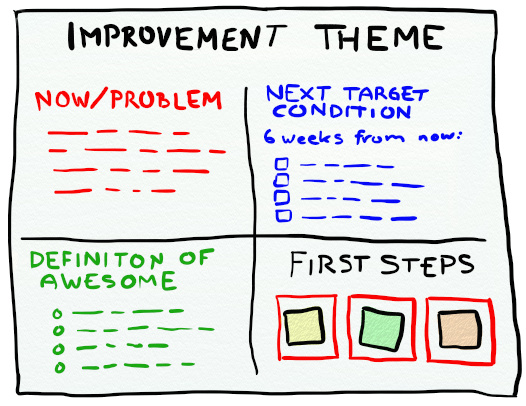Improvement Process
As organisations & teams mature or change there is always a need for processes to change too. There is never one process that works for every team, all the time and things need changed / adapted over time.
For this reason the most important part of our Engineering Culture is the improvement process. We're always looking to change or adapt our processes to better fit our needs as they change and for keeping track of this we have our improvement process.
The End of Sprint Retrospective
At the end of every sprint we have an approx 1 hour meeting called a retrospective. In this meeting we talk about what has went well in the past sprint and areas we should look to improve or change. Usually improvement suggestions that come out of this meeting are immediately actionable and we take that action straight away. In some cases though it may take a bit of work and in that case we create an Improvement Theme following the popular Improvement Kata format.
Improvement Theme

The graphic above (credit: Jimmy Janlen) is a great illustration of the format we use to track Improvements. Any larger improvements we have to make we simply track as an improvement theme in the teams confluence space and make sure they're visited in every retrospective. This makes sure we're actively working towards making these improvements and not just talking about it.
Failure Board

Failure is a part of everything we do or try and we find that totally acceptable. What's important for us is to learn from our mistakes and openly talk about it. For that we have our Failure Board in confluence beside our Improvement Themes. This is a simple list of failures that have happened and actions that were taken because of that. Over time this will also become a list of war stories we can laugh about at a later stage ;)
Raising Problems
While we should always assume peoples best intentions and we should communicate publicly where possible there can be times when a problem occurs in the team that you feel needs to be discussed privately. If this happens, then your first port of call should be your line manager. If for some reason this is not possible then please raise the concern with either Marty Cochrane (CTO) or Gavin Allison (Product & Delivery Manager). If the issue is serious or urgent then you could escalate to Simen Kortgaard (CEO).
It is often helpful to take some notes about an issue to organise your thoughts prior to discussing it. If there is evidence of the issue then please also gather that too.
All reported issues will be discussed and you will be taken seriously. If an investigation is required it will be carried out in good time. While we value transparency please be aware that, depending on the result of the investigation, you may not get full details of the outcome.
Our aim is to resolve issues quickly and after the first report. However, if an issue reoccurs then please follow up.